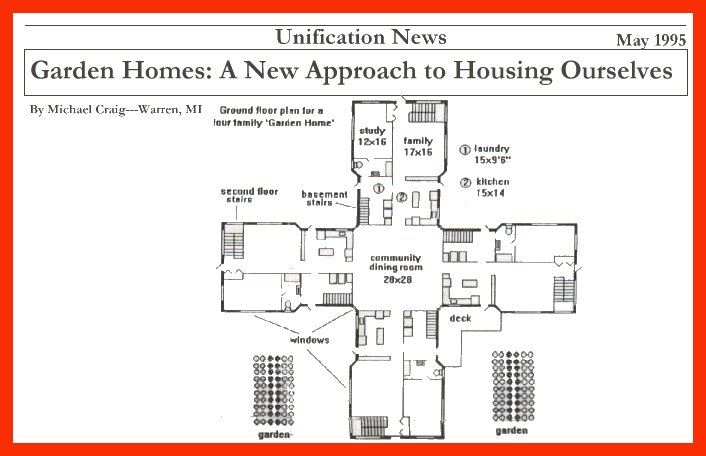
CHAPTER ONE
Cohousing -- God's Ideal Capitalist Communities
Michael Craig's vision
In the May, 1995 Unification News Michael Craig wrote an article called "Garden Homes: A New Approach to Housing Ourselves."

He wrote that "it would be impossible to succeed in our collective mission unless we pulled together" but unfortunately there is no "consensus on how this could be accomplished." The members in Detroit only met "on Sundays and special occasions. As each family became involved in the struggle to feed, clothe and shelter themselves, there was little time and energy left to promote a significant transformation of our collective social environment. In this regard, the concept 'where two or more are gathered' took on a new meaning for me. Single families existing miles apart would never succeed in bringing about the kind of radical change implied by True Parent's tradition. However, a physical community (minimum of four families) could perhaps generate enough 'critical mass' to tilt the scales."
This sure sounds great to me. Let's do it. The problem of course is that these couples must love each other. Families could begin the process by visiting each other's house and have potluck. Over time, if they gel then they can get the finances and commitment to live together. This brother's "vision" was families eating together in a community dining room and having room for gardens. He says there would be great savings and mutual aid by having "cooperation in food buying, babysitting, and a hundred other details of everyday life. There could be co-sharing of big ticket items such as lawnmowers, power tools, etc., as well. It is easy to imagine parents (and older children) having weekly meetings in the community dining area (perhaps over dinner) to discuss ways to cooperate to further reduce the economic burden of raising families. This would free each to devote more time to witnessing and teaching."
COHOUSING
I 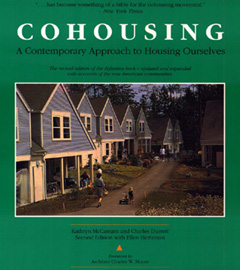 agree. But I'd like to expand this
brother's vision to communities that already exist and direct you to the book CoHousing
by Charles Durrett and Kathryn McCamant that shows beautiful colored pictures of
communities in Denmark that share a communal dining room called the "common
house."
agree. But I'd like to expand this
brother's vision to communities that already exist and direct you to the book CoHousing
by Charles Durrett and Kathryn McCamant that shows beautiful colored pictures of
communities in Denmark that share a communal dining room called the "common
house."
DENMARK
At the website www.cohousing.org we read: "The first attempt to build a Danish cohousing community began in the winter of 1964 when Danish architect Jan Gudmand-Hoyer gathered a group of friends to discuss current housing options. Over several months, this circle of friends discussed possibilities for a more supportive living environment. By the end of the year, they had bought a site on the outskirts of Copenhagen and developed plans for twelve terraced houses set around a common house and swimming pool. Gudmand-Hoyer went on to write an article entitled 'The Missing Link between Utopia and the Dated One-Family House,' in which he described his group's ideas and their project. When published in a national newspaper in 1968, the article elicited responses from over a hundred families interested in living in a similar community.
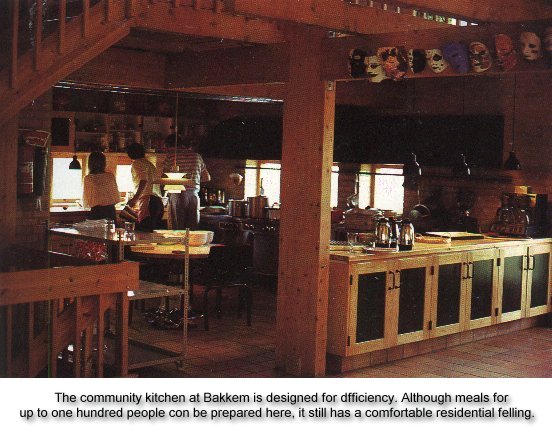
"At the same time, others were writing about similar ideas, including Bodil Graae. Her 1967 article, 'Children Should Have One Hundred Parents,' led to a group of fifty families interested in creating 'a housing collective with the common denominator 'also for children.'"
UTOPIA
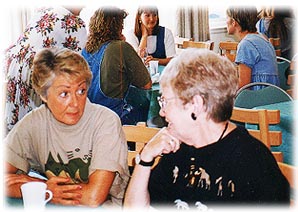 As I write in my
book Clear Goal for Utopia, Rev. Moon often talks about how God wants us to live in
a utopia. It is interesting that the founders of cohousing wrote an article saying it is
the link between utopia and the lonely homes in the suburbs and apartment complexes Satan
has designed. I also like the title of the article saying that children should have many
parents. The missing link between cohousing and an absolute world-wide utopia is the
Divine Principle. Tight-knit communities centered on the theology and lifestyle of the
Principle will be the Kingdom of Heaven on Earth.
As I write in my
book Clear Goal for Utopia, Rev. Moon often talks about how God wants us to live in
a utopia. It is interesting that the founders of cohousing wrote an article saying it is
the link between utopia and the lonely homes in the suburbs and apartment complexes Satan
has designed. I also like the title of the article saying that children should have many
parents. The missing link between cohousing and an absolute world-wide utopia is the
Divine Principle. Tight-knit communities centered on the theology and lifestyle of the
Principle will be the Kingdom of Heaven on Earth.
Several of these cohousing communities have been built in America. Please go to the library and check the book out. It is exciting to see how wonderful these communities are. The genius of these planned communities is that they blend private and public property. Each family has their own fully equipped apartment or house with its own kitchen close to all the others.
INDIVIDUALISM
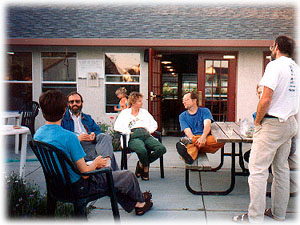 To those who would say that it is a pipe
dream that Americans -- and even American Unificationists -- will give up their lonely
lives in suburbs and stretch to live close to others, I would like to point out that very
few have heard of the concept of cohousing and as it gets more popular, then more will
join.
To those who would say that it is a pipe
dream that Americans -- and even American Unificationists -- will give up their lonely
lives in suburbs and stretch to live close to others, I would like to point out that very
few have heard of the concept of cohousing and as it gets more popular, then more will
join.
But I agree that most people will not get excited about the external arrangement of cohousing. That will come when the internal has changed. People stay away from others because they are disunited in ideology. When the Principle sweeps the earth, then people will want to be with others. Are Unificationists ready for close communities? As they learn about cohousing, I pray that they will give up living away from members and want to build privately owned homes next to other members.
Groupism
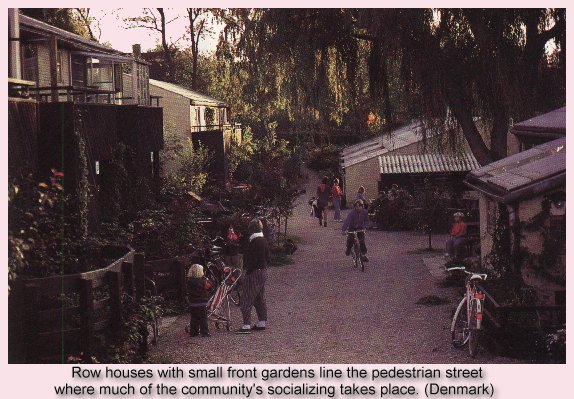 Father is critical of Americans being so
individualistic and perhaps many UC members have been digested by our culture also. It
would be more precise to use the word "feminism" instead of individualism
because the ideology of feminism is what has caused people to be divided. Here's the
logic. The opposite of individualism would be, to coin a word, groupism. What is the basic
group of mankind? It is the family. What philosophy is against Godly families? Feminism
hates the patriarchal, traditional family.
Father is critical of Americans being so
individualistic and perhaps many UC members have been digested by our culture also. It
would be more precise to use the word "feminism" instead of individualism
because the ideology of feminism is what has caused people to be divided. Here's the
logic. The opposite of individualism would be, to coin a word, groupism. What is the basic
group of mankind? It is the family. What philosophy is against Godly families? Feminism
hates the patriarchal, traditional family.
To those Unificationists who say they are against patriarchy I would remind them that the first generation stood in front of a man who they called "Father" and let him make the greatest decision of their lives for them. He confidently made tens of thousands of decisions in matching couples to be married. Mother did not and as far as I can tell she still isn't even though some male leaders in the UC have done some matching. Father is the epitome of a patriarch. When it comes time to make the many decisions in his world-wide organization he makes them with total confidence. It is not parentism or familism, but patriarchy that is the dominate philosophy of Father. When American Unificationist sisters stop being bones as Father chastises them, then the UC will come together in community. As long as sisters are working for money and looking down on men as not the final decision makers in their homes, then the American UC will continue to not grow.
When the UC rejects the feminism that has corrupted the church and restore traditional family values to blessed couples then sisters will want to live close to other sisters so they can help each other, and brothers will then be strong and able to earn good incomes to build homes that can house 10 or more children. They will have the money to adopt, if necessary, and care for a large family and to help other families and the church financially. Sadly, the UC is made up of men who act like "flesh." They are wimps who do not teach the Principle with power and results. When was the last time you saw a UC brother witness, teach, convert and raise another man to be spiritually strong and go out and duplicate him?
The traditional family is the extended family because women care for the elderly, not put them in nursing homes so they can be free to work outside the home. As America has gotten more feminist every year in the 20th century, divorce has increased and now half of all children are born out of wedlock. The family and therefore the community has been destroyed by feminism. The UC needs to sell off any churches it has and build cohousing communities. To do this, the leadership in the church and the men in their homes must get their wives out of the workplace and back into the home. This will give the spiritual energy and focus to build successful careers and be the spiritual head of their homes. This will lead to brothers teaching the Principle. The Principle is the last thing the most brothers in the UC think about. They are emasculated and feminized.
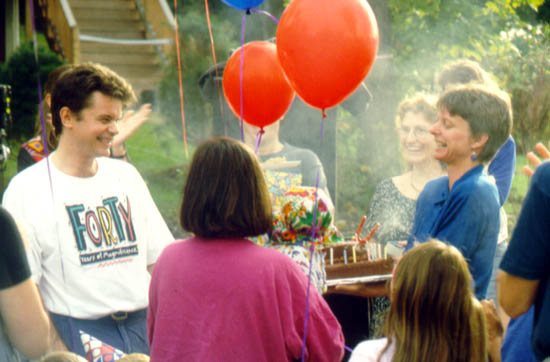
COMMON HOUSE
In cohousing communities most people have their dinners in the Common House. In many
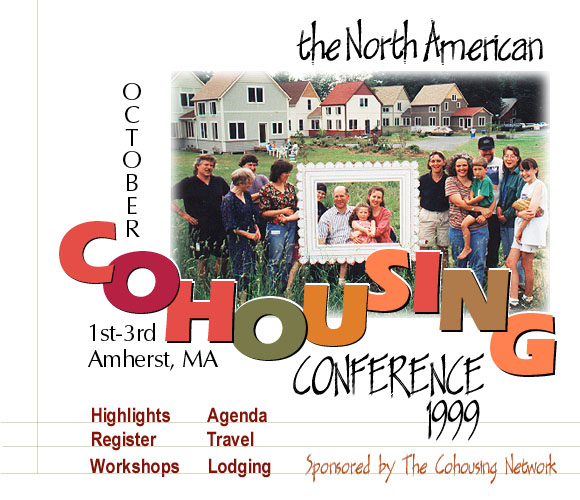 communities people only cook once or twice
a month. Let's say there are thirty families. That means each
family cooks for everyone once a month. That leaves the women free from dinners for the
rest of the month! And no dishes to do. Imagine how stressful it is for women to have to
put dinner on the table their whole life. And the one night a month she does it, many
families do it together or two families do it together. It is fun. McDonalds always has
breakfast, lunch and dinner. If families lived in communities it would be like a hospital
that always runs. No one can guarantee they will not get sick or even live to old age.
Community is God's insurance. No one can be there physically and
emotionally at all times. We need friends. Hospitals can run around the clock because
there are many people committed to be there. Our homes should operate as well as a
hospital or McDonalds. In fact they should be even better because of the love of everyone.
To manage a home alone is simply too much for one couple to do. Especially if there is a
war and men must go to fight. Community gives us security. This world will go into
Completion Stage when it gives up individualism for community living based on the
cohousing example. An added benefit of living in such communities is that people are much
less inclined to leave. It stops the incessant mobility that has ripped apart families. It
would encourage extended families living together and having businesses and investments
locally. This would increase the power of grandfather patriarchs and love of elders. The
Bible says a good man leaves an inheritance to his children's
children. Living this way would create empires where descendants would be born with all
the financial wealth and love and support he or she would ever need.
communities people only cook once or twice
a month. Let's say there are thirty families. That means each
family cooks for everyone once a month. That leaves the women free from dinners for the
rest of the month! And no dishes to do. Imagine how stressful it is for women to have to
put dinner on the table their whole life. And the one night a month she does it, many
families do it together or two families do it together. It is fun. McDonalds always has
breakfast, lunch and dinner. If families lived in communities it would be like a hospital
that always runs. No one can guarantee they will not get sick or even live to old age.
Community is God's insurance. No one can be there physically and
emotionally at all times. We need friends. Hospitals can run around the clock because
there are many people committed to be there. Our homes should operate as well as a
hospital or McDonalds. In fact they should be even better because of the love of everyone.
To manage a home alone is simply too much for one couple to do. Especially if there is a
war and men must go to fight. Community gives us security. This world will go into
Completion Stage when it gives up individualism for community living based on the
cohousing example. An added benefit of living in such communities is that people are much
less inclined to leave. It stops the incessant mobility that has ripped apart families. It
would encourage extended families living together and having businesses and investments
locally. This would increase the power of grandfather patriarchs and love of elders. The
Bible says a good man leaves an inheritance to his children's
children. Living this way would create empires where descendants would be born with all
the financial wealth and love and support he or she would ever need.
In Cohousing developments cars are parked in one place. There is walk ways and play
areas between the houses and large spaces of land for gardens and for kids and dogs to
run. It is a perfect blend of privacy and community. The early communities in Denmark
stressed private areas over public, but experience showed that people enjoyed getting
together so much that later communities emphasized public areas. Satan has made America
individualistic. The American Dream of a single family dwelling has become a nightmare for
many people. Criminals usually do not attack groups. There is strength in numbers. The
stress for one woman to always put a meal on the dinner table everyday for 50 years is too
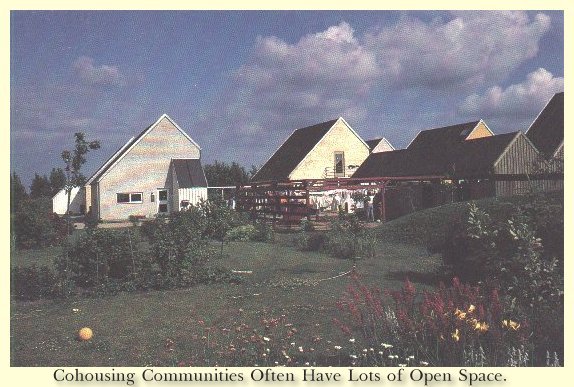 much. Men trying to figure everything
out alone drives them to drink and TV. In CoHousing the authors write:
"Developed by the residents themselves, cohousing combines the autonomy of private
dwellings with the advantages of shared facilities and community living." In another
book on communities, Builders of the Dawn, the authors spend a few pages on many
communities in America. Some are totally socialistic. No private property. It works for
some. The most successful though are capitalistic cooperative ventures. The ideal world
will be everyone owning their own property and sharing common areas. It's like an advanced
form of condominiums. Legally everyone owns and could sell his property but there are
group legalities to honor.
much. Men trying to figure everything
out alone drives them to drink and TV. In CoHousing the authors write:
"Developed by the residents themselves, cohousing combines the autonomy of private
dwellings with the advantages of shared facilities and community living." In another
book on communities, Builders of the Dawn, the authors spend a few pages on many
communities in America. Some are totally socialistic. No private property. It works for
some. The most successful though are capitalistic cooperative ventures. The ideal world
will be everyone owning their own property and sharing common areas. It's like an advanced
form of condominiums. Legally everyone owns and could sell his property but there are
group legalities to honor.
The advantages of living this way are enormous. A man's role is to protect his family and in these communities there are many kids who play together and women sharing babysitting and all the kids are watched constantly. They are safe. The book CoHousing explains some of the exciting things people have done. Some have pooled their resources and done things together they could never do alone. In writing on a community called Trudeslund they say: "Twenty-nine of the households have also pooled their resources to buy a 17-room vacation house in Sweden." Some families share a car, some got together and bought a sailboat. "There is only one lawn mower. Items needed only occasionally, such as tools, typewriters, and camping equipment, can generally be borrowed or shared, instead of each family owning one of everything. (we could share in buying father's boats). This sharing of resources gives all residents access to a wider variety of conveniences at a lower cost per family than is possible in traditional single-family houses." There are so many advantages to having a community of friends. They write, "With nearly fifty children living in Trudeslund, there is no lack of playmates. The pedestrian-oriented site gives them lots of room to run without worrying about cars. The community serves as a large, extended family -- children have many people besides their parents to look after them, to whom they can turn for assistance, or just to talk to. It becomes second nature for the older kids to keep an eye on the smaller ones, and the adults know every child by name."
They write, "Also located in the common house are a workshop, a darkroom for
photography, a television room, a walk-in freezer used by the community store and
individual families, a guest room, and a music room where teenagers can jam' on drums and 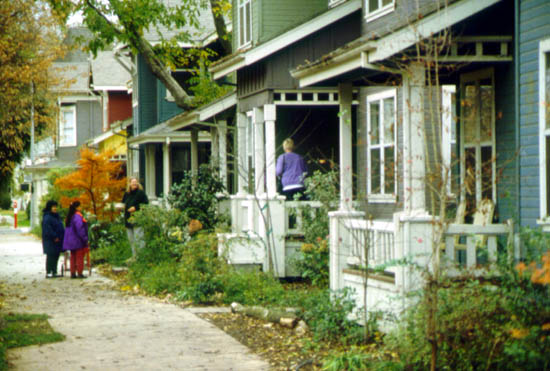
electric guitars without bothering anyone. A recent addition is the computer." Wouldn't this building be perfect for school? Instead of home schooling -- we'd have community schooling. The creative arrangements between people are endless. There is a magazine called Communities and it has ads for Cohousing projects. One was in Bainbridge Is., Washington called Winslow Cohousing. They say they will send an information pack for $3. (353 Wallace Way N.E. Bainbridge Is., WA 98110 206-780-1323)
In their ad they say, "We are a pedestrian village within walking distance of the Seattle ferry, schools, stores and library. We are looking for a few more members who value privacy of their own fully equipped homes, and enjoy living in a cooperative community. We share a 5,000 sq. ft. Common House with dinners five times a week, cooperative childcare, recreation facilities, playground, orchard, woods, and garden, as well as a variety of skills, fun and friendships." What if we did this? There are a number of these communities in America and more are being built. We have attended meetings of a group trying to start one in our town but we only want to live with others who believe in True Parents and share our values of men providing and women staying home. Another community I read about was one in New York. Write to EcoVillage at Ithaca, Anabel Taylor Hall, Cornell University, Ithaca, NY 14853; (607) 255-8276. There is a newsletter and resources about cohousing from The CoHousing Network, PO Box 2584, 1259 Addison Street, #113, Berkeley CA 94702, (510) 526-6124. They have lists of groups nationwide, legal documents, slides and a video of clips assembled from national and local news programs. The video is 20 minutes long and does a good job of giving a visual idea of what these communities are like. People living in them are interviewed. It makes you want to live there just as you want to live with members when you hear the Principle.
What is Cohousing? One 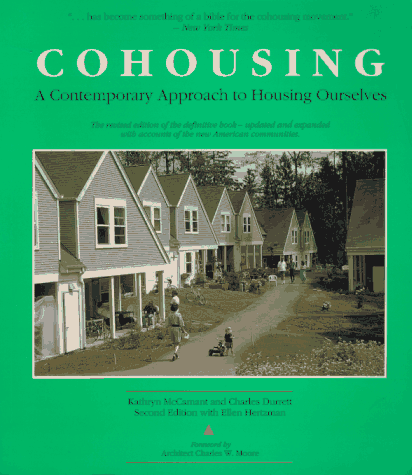 article explains
it this way: "If you haven’t yet heard of 'cohousing,' you soon will. The
media is starting to pick up on this cultural development as it grows exponentially."
article explains
it this way: "If you haven’t yet heard of 'cohousing,' you soon will. The
media is starting to pick up on this cultural development as it grows exponentially."
Cohousing satisfies the need for "both the desire for privacy and the yearning for a greater sense of community. You own your own home in a cohousing development, but residents participate in a number of communal activities, such as a weekly dinner. Parking is restricted beyond a specific perimeter, so children may safely play. Oftentimes, families live next door to retired folks, so acquiring babysitting services is easy."
"In a way, cohousing is a recreation of European-style village life. In fact, it originated on the continent, in Denmark. It came across the Atlantic in 1988. Since then, 28 cohousing projects have been built. One hundred and fifty are on the way, so it’s clear that many people are attracted to that way of life."
"People own their own homes, and earn their own incomes. There aren’t group dwellings and there isn’t income redistribution."
"Those are fairly significant differences from the hippie communes formed in
the 1960s.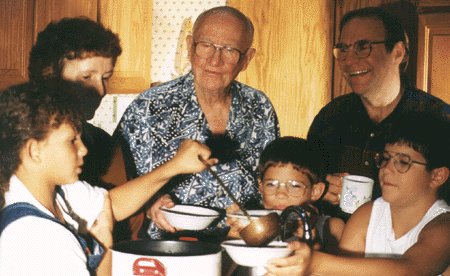 Cohousing seems
to be providing the way of life the counterculture yearned for, but with a twist—it
uses the tools of capitalism."
Cohousing seems
to be providing the way of life the counterculture yearned for, but with a twist—it
uses the tools of capitalism."
At the website www.cohousing.com a cohousing community has a website. They are the Pioneer Valley Cohousing Community in Amherst, Massachusettes. They write, "What is Cohousing -- Cohousing is a Danish concept that came to the United States in the late 1980s and is quickly gaining momentum across the country. Members own individual homes and maintain their privacy and autonomy while sharing meals, activities, facilities and, most important, a community spirit."
"Physical Layout"
"Homes are clustered on about six acres of the site and oriented around a pedestrian walkway. Standard designs were developed, but all units were customized, to some extent. There are eight detached homes, nine duplexes, and two triplexes. The 4500-square-foot common house includes a kitchen, dining room, living room, sitting room, library, children's room, and two guest rooms. There is also a large, unfinished basement with a laundry room, a food pantry, and some storage space, as well as an area geared for older children. Four member households financed a home office building across the green from the common house. A 1600-square-foot annex, with space for crafts, woodworking, and equipment storage space, was built by and for members of the community."
 "Community
Meals"
"Community
Meals"
"Meals are prepared and served by the community every Monday and Wednesday evening. Planning and preparation are done by neighborhood teams. Each team is responsible for two meals every five weeks. There are dinner "clubs" on Tuesday and Thursday evenings, with regular members taking turns as chef, and occasional weekend brunches and potlucks."
"Half to three-quarters of our members dine at regular meals, and there are frequent guests, as well. Whenever possible, meals are planned around the produce from our organic garden."
The website defines it this way:
"Cohousing is the name of a type of collaborative housing that attempts to overcome the alienation of modern subdivisions in which no-one knows their neighbors, and there is no sense of community. It is characterized by private dwellings with their own kitchen, living-dining room etc, but also extensive common facilities. The common building may include a large dining room, kitchen, lounges, meeting rooms, recreation facilities, library, workshops, childcare."
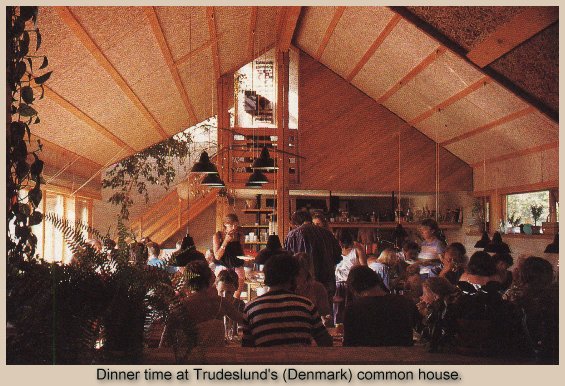 "Usually,
cohousing communities are designed and managed by the residents, and are intentional
neighborhoods: the people are consciously committed to living as a community; the physical
design itself encourages that and facilitates social contact. The typical cohousing
community has 20 to 30 single family homes along a pedestrian street or clustered around a
courtyard. Residents of cohousing communities often have several optional group meals in
the common building each week."
"Usually,
cohousing communities are designed and managed by the residents, and are intentional
neighborhoods: the people are consciously committed to living as a community; the physical
design itself encourages that and facilitates social contact. The typical cohousing
community has 20 to 30 single family homes along a pedestrian street or clustered around a
courtyard. Residents of cohousing communities often have several optional group meals in
the common building each week."
The webstie www.cohousing.org lists all the cohousing in america and parts of the world. Many have their own website and some give pictures of their communities. Also listed are groups in cities that are trying to form a community. One of the best websites for community is the Intentional Communities site at: www.ic.org. It lists many communities around the world and has some great information on the philosophy of community.
Songaia
At 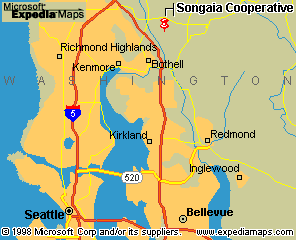 the website (www.songaia.com) for a
cohousing community in Seattle called Songaia one of the residents writes:
the website (www.songaia.com) for a
cohousing community in Seattle called Songaia one of the residents writes:
Imagine living in a neighborhood where you actually know your neighbors.
Not just the occasional "Hello, how are you?" at the mailbox, but real friendships based on shared values, interests and social activities.
Kids (with some Parents) having fun in Songaia's community dining room. Imagine living where you feel safe and where your children can play freely; at the playground, on the sidewalk or in the woods without worries about dangerous strangers and speeding cars.
Imagine living in a place where resources are shared and the idea that "It takes a village to raise a child" is taken seriously.
This is cohousing at Songaia and this is how I imagine life for my
family in the not so distant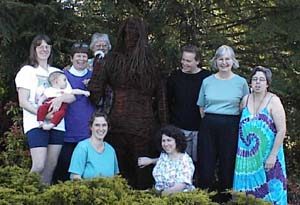 future.
future.
I am looking forward to many things - one of which is community dinners. Most evenings we will get to eat with our friends and only have to cook every few weeks!
Women of Songaia, w/Baby Ian, at their 1999 annual Women's Retreat. The dark central figure is a sculpture of a woman that didn't photograph particularly well...
Some of Songaia's shared kitchen tools, from left to right: a Sony radio/CD
player, Champion juicer, marble mortar & pestle, Vita-mix blender, Cuisinart
food processor, and 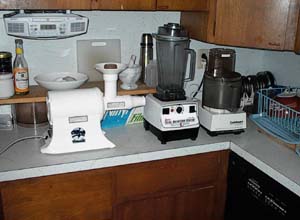 KitchenAid
dishwasher.
KitchenAid
dishwasher.
I find the idea of access to quality tools, appliances and equipment that we might not be able to afford or find space for on our own appealing as well. I don’t need to personally own a Vita-mix, a Kitchen Aid, a bread machine a juicer etc. because these are things that we can all shared.
I want my kids to be around animals, but I am not so keen on dog ownership. Other folks have dogs and they welcome any attention that my kids care to lavish on them.
I am also excited about sharing chores. Doing the dishes by myself
isn’t much fun, but doing 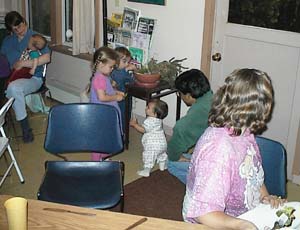 them with a
friend can be a good opportunity to chat. I hate weeding, but I will
probably never have to do it as there are other people who find it relaxing
(something that mystifies me). I can find other ways to help. These are just
a few of the many things that make me
them with a
friend can be a good opportunity to chat. I hate weeding, but I will
probably never have to do it as there are other people who find it relaxing
(something that mystifies me). I can find other ways to help. These are just
a few of the many things that make me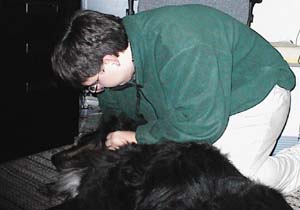 smile when I think
of our future at Songaia.
smile when I think
of our future at Songaia.
Teenager, Zeph, petting Ursa, a very big, very friendly dog enjoyed by many at Songaia.
Go to dpcopy1.tripod.com/1_community/pictures1.html to see more pictures of some cohousing communities.